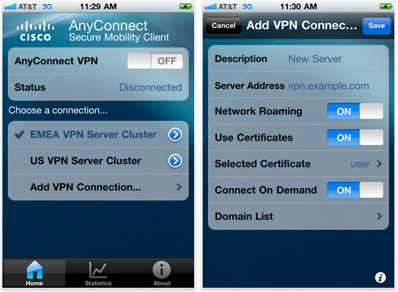Cisco AnyConnect - Empower your employees to work from anywhere, on company laptops or personal mobile devices, at any time. AnyConnect simplifies secure endpoint access and provides the security necessary to help keep your organization safe and protected. Cisco AnyConnect provides reliable and easy-to-deploy encrypted network connectivity from any Apple iOS by delivering persistent corporate access for users on the go. Whether providing access to business email, a virtual desktop session, or most other iOS applications, AnyConnect enables business-critical application connectivity. If AnyConnect only prompts for a password, like so: After you submit your login information, an authentication request is automatically sent to you via push to the Duo Mobile app or as a phone call. Alternatively, you can add a comma (“,”) to the end of your password, followed by a Duo passcode or the name of a Duo factor. APPLICATION DESCRIPTION: AnyConnect for Kindle Fire HD provides reliable and easy-to-deploy encrypted network connectivity from Kindle Fire HDs and new (2012) Kindle Fires to Cisco VPN head-ends (including Cisco ASA 5500 Security Appliances)by delivering persistent corporate access for users on the go.
The Cisco AnyConnect Secure Mobility client is a web-based VPN client that does not require user configuration. Use Cisco AnyConnect VPN to securely access the Student Information System (SIS) and other IT administration systems VPN, also called IP tunneling, is a secure method of accessing USC computing resources.
This page provides instructions on how to download, install, and connect to the Cisco AnyConnect Secure Mobility client from mobile devices that runs the Android operating system.
Note: Due to the many different types of Android devices, not every Android-based device will work in the same way. ITS is not able to guarantee that these instructions will work on every Android device (4.0 and later). This documentation was created using Android 4.2.2 on a Samsung Galaxy Tab.
Installing and Configuring the Cisco AnyConnect Secure Mobility Client
To install and configure the Cisco AnyConnect Secure Mobility client on an Internet-connected Android device:
- Download and install the AnyConnect ICS+ client from the Google Play Store.
- Once the app has finished installing, select Open to launch the application.
- On the next screen, click OK to accept the license agreement.
- To configure your USC VPN connection, tap Connection.
- On the Advanced Preferences screen, tap Add New VPN Connection.
- On the Connection Editor screen, fill in the following information:
- In the Description field, type USC.
- In the Server Address field, type sslvpn2.usc.edu and then tap Done.
Connecting to VPN
Once you have configured your USC VPN connection, you will need to take the following steps every time you want to connect to VPN:
- Choose the appropriate VPN Group Authentication Profile for your location from the Group pull-down menu. For information describing each of these authentication profiles, please see the VPN Frequently Asked Questions page.
- In the Username field, enter your USC NetID username. Your USC NetID username and password are the username and password you use to connect to services such as my.usc.edu and Workday.
- In the Password field, enter your USC NetID password.
- Tap Next.
NOTE: The first time you connect, you will be asked to trust the application. Check the box next to I trust this application. to accept this and connect to VPN.
Disconnecting from VPN
To disconnect from VPN, move the slider next to AnyConnect VPN to Off.
Getting Help
If you need help installing and connecting to your AnyConnect Secure Mobility client, contact the ITS Customer Support Center.
Depending on how your company configured Duo authentication, you may or may not see a “Passcode” field when using the Cisco AnyConnect client.
Single Password with Automatic Push
If AnyConnect only prompts for a password, like so:
After you submit your login information, an authentication request is automatically sent to you via push to the Duo Mobile app or as a phone call.

Alternatively, you can add a comma (“,”) to the end of your password, followed by a Duo passcode or the name of a Duo factor. Here's how:


| Type... | To... |
|---|---|
| password,passcode | Log in using a passcode, either generated with Duo Mobile, sent via SMS, generated by your hardware token, or provided by an administrator. Examples: 'mypass123,123456' or 'mypass123,1456789' |
| password,push | Push a login request to your phone (if you have Duo Mobile installed and activated on your iOS, Android, or Windows Phone device). Just review the request and tap 'Approve' to log in. |
| password,phone | Authenticate via phone callback. |
| password,sms | Get a new batch of SMS passcodes. Your login attempt will fail — log in again with one of your new passcodes. |
You can also add a number to the end of these factor names if you have more than one device registered. For example, push2 will send a login request to your second phone, phone3 will call your third phone, etc.
Examples
To use Duo Push if your password is 'hunter2', type:
To use the passcode '123456' if your password is 'hunter2', type:
To send new SMS passcodes to your second phone if your password is 'hunter2', type:
The comma is Duo's default separator character between your password and the Duo factor. Your administrator may have changed this to a different character. Be sure to follow the instructions sent to you by your organization if they differ from what's shown here.
Second Password for Factor Selection
If AnyConnect shows a 'Second Password' input field (note that your AnyConnect administrator may have changed the 'Second Password' label to something else):
Use the 'Second Password' field to tell Duo how you want to authenticate. Here's how:
| Type... | To... |
|---|---|
| A passcode | Log in using a passcode, either generated with Duo Mobile, sent via SMS, generated by your hardware token, or provided by an administrator. Examples: '123456' or '1456789' |
| push | Push a login request to your phone (if you have Duo Mobile installed and activated on your iOS, Android, or Windows Phone device). Just review the request and tap 'Approve' to log in. |
| phone | Authenticate via phone callback. |
| sms | Get a new batch of SMS passcodes. Your login attempt will fail — log in again with one of your new passcodes. |
Cisco Anyconnect Mobile App Install
You can also add a number to the end of these factor names if you have more than one device registered. For example, push2 will send a login request to your second phone, phone3 will call your third phone, etc.
Examples
To send a Duo Push request to your primary phone, type:

To send a Duo Push request to your secondary phone, type:
To use the passcode '123456', type:
Cisco Anywhere App
Cisco Anyconnect Secure Mobile Client App
To send new SMS passcodes to your second phone, type:
